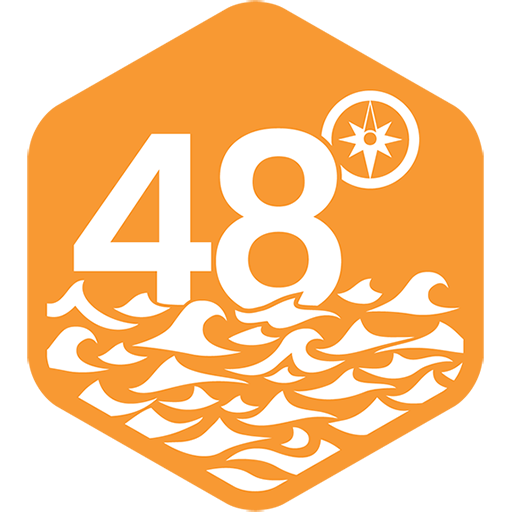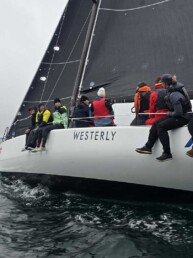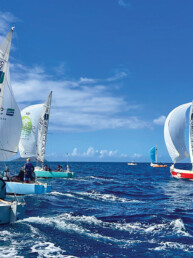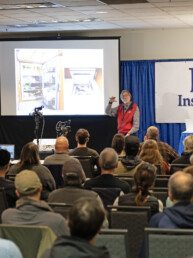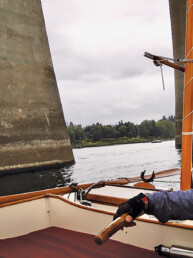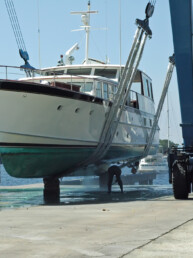 One of the amazing aspects of boats are the attributes that make a design timeless. New school or old, boats that are both fun to sail and well built will stand the test of time. Add in a family-and-friends approach to a racing program, and it’s a win all around for those who get to cash in on the thrills and spills. Such is life for the ownership group of John Hoag, Jack Killalea, JJ Hoag, Will Nelson, Tim Player, and Ric Peterson, and their beloved 1983 Hobie 33, TC.
One of the amazing aspects of boats are the attributes that make a design timeless. New school or old, boats that are both fun to sail and well built will stand the test of time. Add in a family-and-friends approach to a racing program, and it’s a win all around for those who get to cash in on the thrills and spills. Such is life for the ownership group of John Hoag, Jack Killalea, JJ Hoag, Will Nelson, Tim Player, and Ric Peterson, and their beloved 1983 Hobie 33, TC.
Purchased in 2022 and homeported at Shilshole Bay Marina in Seattle, TC has a distinguished pedigree and is a regular on race courses (and podiums) throughout the Salish Sea—TC was 4th in 48° North’s Top 25 for 2024. We’re thrilled that TC’s most frequent skipper, JJ Hoag, is sharing stories of her family’s history with Hobie 33s, her arc of getting to know and love TC, and giving us a glimpse into some exciting plans ahead for this rad sailor and her boat.
What’s the story behind the boat’s name?

The Hobie 33 was an iconic boat in the 1980s and 1990s, and as passionate Hobie Cat sailors, my dad, John Hoag, and his brother-in-law, Todd, were eager to buy one. They teamed up and purchased a boat that they named Wild Thing. They successfully campaigned the boat in Puget Sound, winning the Hobie 33 North Americans before selling it and continuing their adventures on other boats. Tragically, in 2014, Todd passed away unexpectedly. My dad lost not only his sailing partner, but his best friend. Todd was always a “funkle” to me—the fun uncle—introducing me to the joys of racing Hobie 16s and teaching me everything he knew about sailing.
Fast forward to 2021, and my dad and his longtime sailing friend, Ric Peterson (who previously owned the well-sailed Hobie 33 Masked Man), began looking for a new boat, and the Hobie 33 was at the top of the list. Even though the design wasn’t modern, it remained a fantastic racing vessel and a more affordable alternative to newer designs. I think, too, that they wanted to relive the glory days of the 1990s.
We found the perfect boat in California, and for my dad, purchasing his second Hobie 33 thirty years after the first one brought back many cherished memories of Todd. To honor the legacy of one of the great Hobie sailors, a wonderful friend and mentor, and the best uncle, we named the boat TC for Todd Christiansen. I know he’d be incredibly proud of what we’ve done with the boat and the amazing impact it’s had on young sailors in the Pacific Northwest.
Have you owned other boats before this one?
I’ve never owned other boats, but my parents raised me on their race boats from the time I was a baby. We often joke that our family is always buying and selling boats. My dad has this incredible knack for seeing a boat’s potential, putting in the time and energy to make it faster and better, winning races, and then selling it, only to start the process all over again. He taught me the value of investing time in your boat, taking pride in the work, and reaping the rewards. It’s all about maintaining your boat and being proud of its condition. The one boat he hasn’t sold is his 1D35, Shrek, which remains his perfect vessel for Pacific Northwest buoy racing. Over the years, he’s built an amazing community of crew members who love sailing Shrek, making it a boat that will always have a place in our family.
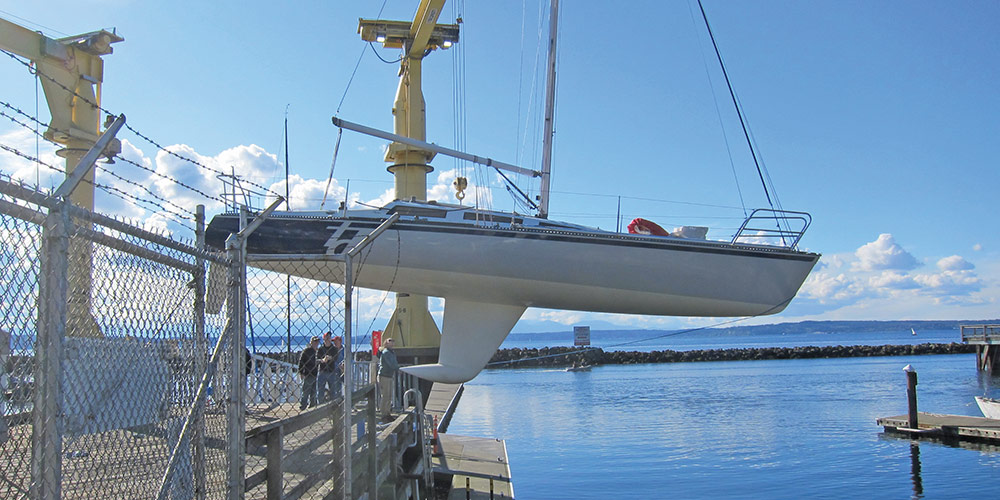
What’s the history of the boat?
The Hobie 33 was designed by Hobart “Hobie” Alter and Phil Edwards in the early 1980s as a racer-cruiser that blends elements of surfboards and catamarans. Hobie aimed to create a fast, lightweight, and easy-to-handle boat for sailors in the middle-income bracket, offering a balance of performance and comfort for both racing and cruising. The design was built by Hobie Cat in the United States from 1982 until 1987, with 187 hulls completed.
According to the original Hobie 33 owners manual, the key design aspects of the boat were:
- Performance: The Hobie 33 is built for speed, whether offshore or across the bay. It features a long waterline, narrow 8-foot beam, lightweight construction (4,000 lbs), a 1,800-lb lead bulb keel with a 5-ft draft, and an inboard-mounted airfoil-shaped rudder. The unique “Motor Well” allows for an outboard engine that can be taken out and plugged for reduced drag when racing. It was “all the newest technology” of the time.
- Trailerability: The retractable keel and 8-ft beam make it road legal, and the deck-stepped mast can be dropped by one or two people.
- Quality Construction: The hull is made from foam sandwiched between fiberglass, ensuring strength and stiffness without excessive weight. There’s a famous video of a Hobie 33 being purposely run aground and dropped from a crane to showcase its durability. Remarkably, that boat is still racing today.
- Class Racing: Designed to create a large one-design class, the Hobie 33 quickly gained popularity, hosting national events across the country, many of which my dad and Todd attended. Today, many have been modified outside of the class rules.
- Transpac: Hobie Alter specifically designed the boat with the Transpac race in mind, including the outboard well. He was committed to a boat that sailed well on the ocean.
- Visual Appeal: The sleek hull and tapered windows give the Hobie 33 its signature fast look.The original Hobie manual has some great quotes such as, “Not only does she look like a rocket at dockside, she behaves like one out on the water.”
Though “The Hobie 33 was crafted to provide both thrilling performance and reliable cruising,” the boat has built its following more for racing ability than cruising comforts. The whopping 4-foot standing head room down below makes it difficult to do really anything, but that’s not why you buy a Hobie 33. It’s cool history for a boat that probably exceeded even Hobie Alter’s dreams and remains an incredible budget-friendly option for sailors who like to go fast.
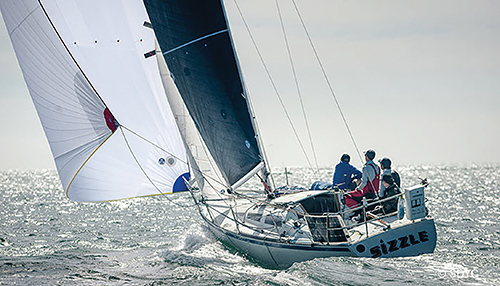
Where did you find the boat?
We bought the boat, previously named Sizzle from Bill Hardesty in San Diego—a talented tactician and helmsman with 12 world championships and a Rolex Sailor of the Year award. Bill had big plans for the boat, including doing the Puerto Vallarta Race and the 2020 Pacific Cup. He put significant effort into preparing it for offshore sailing, overhauling the instruments and rigging, and perfecting the bottom. In the 2020 Puerto Vallarta Race, he and his crew won first overall and North Sails published an article about their win and the boat. However, their plans for the Pacific Cup were derailed by COVID, and Bill decided to sell.
My dad and Ric Peterson drove down to San Diego in early 2022 and were impressed with the boat’s condition and all the work Bill had done. They were able to make a deal and purchase the boat, and then drove it up to Seattle. That spring, we began cleaning the Hobie up, starting new projects, and getting it ready to be back on the water.
What do you like best about your boat?
I was trying to put it politely, but plainly, “It’s because it’s f***ing fast downwind.” Unlike other boats of similar size, which might top out at around 10 knots while surfing, this boat is a skinny Ultra Light Displacement Boat (ULDB) and can hop up on a plane, reaching speeds of 18+ knots. We’ve had some thrilling sleigh rides with our masthead asymmetrical 2.5 kite, and the boat feels like a rocket while we’re just holding on for dear life.
It’s also so light and narrow that we sail it almost like a dinghy, roll tacking in light air, and fine-tuning weight placement for precise balance—a great opportunity for those of us with dinghy backgrounds to apply our knowledge and broaden our horizons. It’s a versatile boat, and it continues to surprise us with how it shines even in conditions that aren’t considered its “strength.”
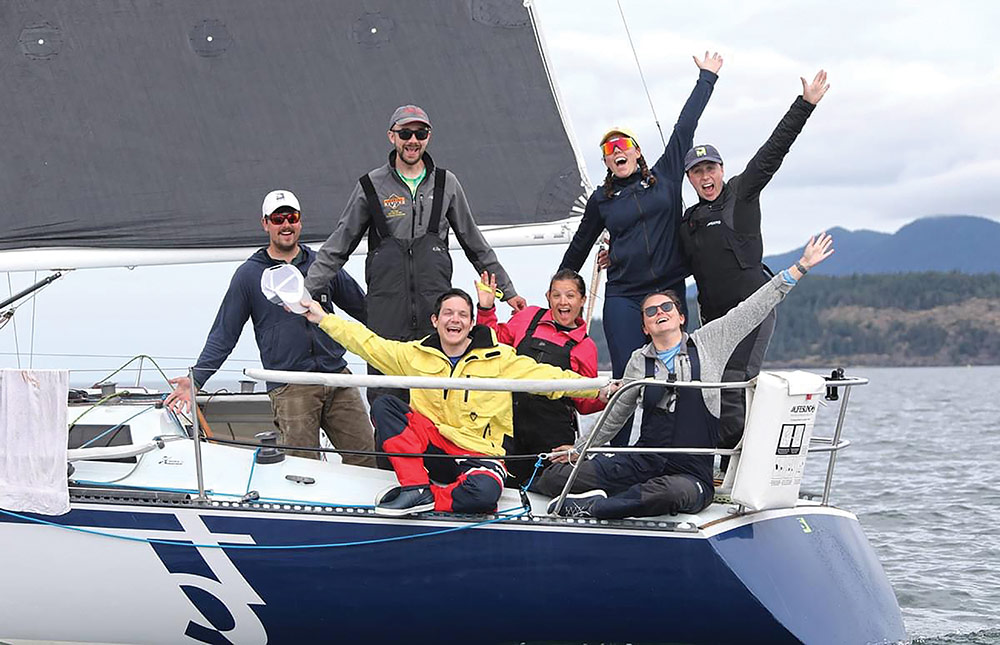
What do you know now about your boat that you wish you’d known when you bought it. Would that have changed your mind?
I’ve learned that the Hobie 33 isn’t an upwind weapon. Its lightweight design and lack of a deep rudder/keel make it harder to point as high as newer boats of similar size. This wouldn’t change my opinion of the boat, but it did take our team a while and some frustration on the upwind legs, to figure out how to improve its upwind performance. It taught me that even with the newest sails and the best crew on board, there’s a critical learning period when you get a new boat.
What’s your favorite story involving your boat?
My favorite moment was our first time getting up on plane going downwind at Round the County in 2023. We debated whether to put the kite up in 30 knots, and I’m sure glad we did. The starting area was crowded with 100 other boats, but once we got some clean air, we could literally feel the boat lift out of the water, with the bow wake flying over the sides and the call for “Weight back!” At times it felt like riding a bucking bronco, but I was smiling ear to ear, watching the boat’s speed climb with every puff. The pure adrenaline and excitement was overwhelming, knowing this is what the boat was famous for—and boy, did it deliver.
Unfortunately, we were going so fast that the leg lasted less than an hour before we had to douse the kite and switch to a reach. But I loved when people on the dock came up and said, “Here comes this little Hobie flying through the fleet. We blinked, and you were gone!” The boat was surprisingly stable under the A2.5, and it didn’t take long to find the groove where she was happy in those conditions.
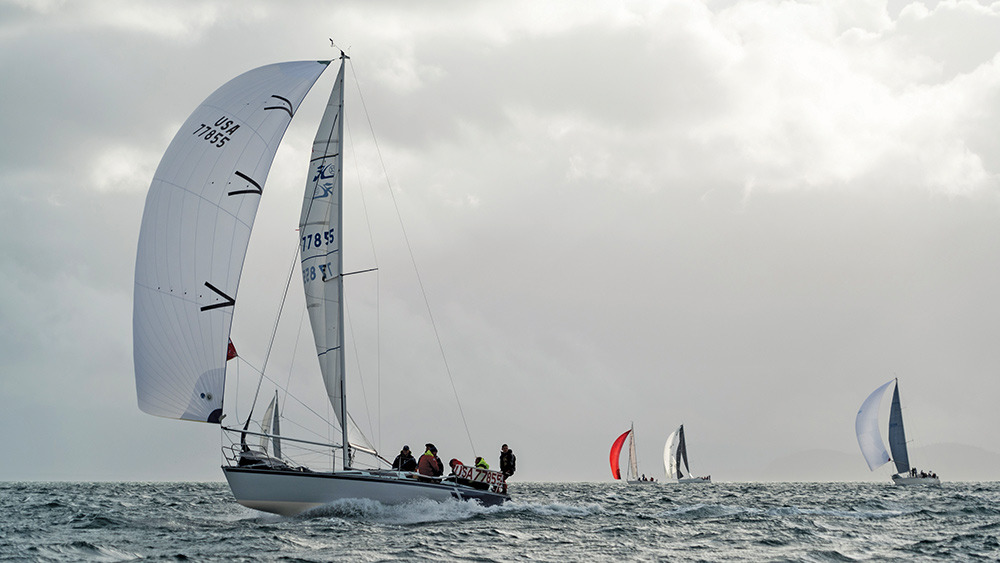
What’s the most challenging situation you’ve faced in the boat?
I’ll admit, during my first Race Week with TC, I felt incredibly defeated because we just couldn’t point upwind like our competitors. We were often nearing the windward mark almost last, only to catch up on the downwind leg, but then lose ground on every tack. I remember people on the dock reassuring me, saying things like, “Hobie 33s are difficult boats” or “Hobie 33s don’t point,” and it was a challenging time for me and tough for my team. We had this exciting new (to us) fast boat, but no one enjoys losing—especially not me. I had the age-old debate in my head: “Is it me or the boat?” Turns out, it was both. For me, it was about patience, learning from the wise sailors around us, not being afraid to fail, and having the courage to make changes and tweaks that would help us learn.
Now, three years later, I’ve developed a specific style for sailing this boat. I know which boats I don’t want to be to windward of at the start line. I purposely position myself in situations where I can foot off a little more to keep the boat happier and in clean air. Once the boat is up to speed, I can point and hold my lane, but it takes considerable effort from both the driver and crew.
A big part of our progress is thanks to my partner, Jack Killalea, who put together a spreadsheet and polar data from various Hobie 33s around the country and their ORC ratings. This has been huge for rig tune adjustments, ensuring our mast is set up for the correct wind speed and headsail. We’ve also dialed in our upwind angles in different wind conditions, so now we race the boat against itself, optimizing her maximum potential before comparing ourselves to the competition.
We’ve gone from “just trying to sail fast” to having specific target measurements and goals that let us gauge how well we’re sailing. But, above all, it took time, patience, and a curious learning attitude. I know we’ll never fully “figure out” this boat because it continues to teach and sometimes frustrate me, but what an honor it is to have a platform with so much potential, one that will grow with us as we become better sailors.

Where do you plan to take your boat?
We have big aspirations to do the Pacific Cup in 2026. Jack and I have always wanted to do more offshore sailing, specifically to Hawaii, and thanks to a lot of work put in by the previous owner, TC is already 90% of the way ready. The Hobie 33 was designed for Hawaii races, so it feels fitting to let it stretch its legs across the ocean. It’s exciting to know that even though this might not be the comfiest ride to Hawaii, it will certainly be a fast one.
If you could have any other boat, what would it be and why?
TC is a special boat for where we are on our sailing journey. It’s not the most comfortable (not even close), fastest, flashiest, or most modern boat on Puget Sound, but it has a certain magic. It has a knack for creeping along in light air when all the other boats come to a stop, and despite the criticism it gets for not pointing well in big breeze, we’ve gotten it to perform exceptionally well in those conditions. We were the first boat overall in the PHRF class in the 2024 Possession Point Race, where we saw wind speeds over 35 knots, as well as 3rd overall and 1st in class in the recent Winter Vashon race with wind speeds in the mid 20s.
It’s hard to think of a better boat to be on when we’re going downwind in 25 knots, and thanks to its ULDB design, the loads are relatively light on the boat. Of course, there are other boats we sometimes envy on the race course. It would be nice to load up the weather rail with 1,200 pounds of water ballast like the Riptide 30 and 35 do when going to weather. There have also been plenty of times we’ve struggled to hold our lane against boats like the Pyramid 30, Scheme, or the Olson 29, Sabotage—boats that point higher and have that extra upwind gear that the Hobie doesn’t quite have. But despite all that, there’s just something about the Hobie 33 that makes it so rewarding to sail.
When everything is tuned right, the boat just goes like nothing else. It’s hard to imagine a better boat for mid-distance racing around Puget Sound, for us anyway.
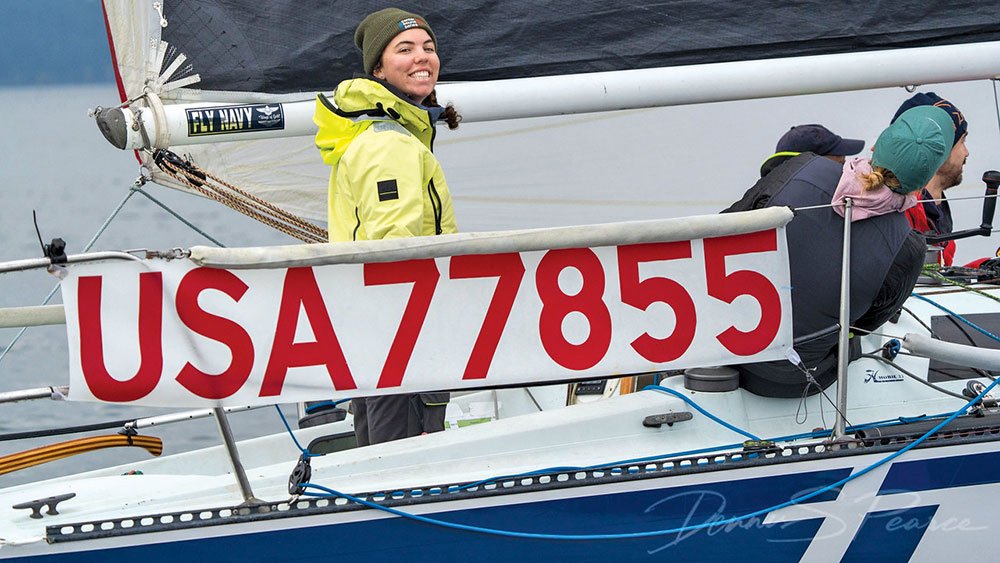
What didn’t we ask you about your boat that you wish we had?
Yes, “Who sails on your boat and why so many owners?” Sailing has always been a family affair for me, and with TC we technically have five different owners involved with the boat. I feel so thankful that we have an amazing team who sees the value in investing in the boat and all pitch in to make it easier and more fun for everyone. My parents taught me that it takes a village to own and sail a boat, and I am fortunate to have such an incredible village of people around to sail and race with.
I have to thank Ric Peterson and my dad who originally bought the boat and poured so much time and effort into it, giving my friends and me the opportunity to eventually buy it from them. I also want to thank Dean Christensen, Todd’s dad, for letting us park the boat in his driveway to work on all our never-ending projects. He’s always our biggest supporter and tracks us on AIS during every race. Tim Player and Will Nelson have been longtime friends that have helped put hours into figuring out this silly boat and always making it a competitive but fun environment. And of course my partner, Jack Killalea, for managing the 15 different lines that come into the pit and keeping us competitive all the time.
While I’ve answered a lot of these questions from my perspective and experience with TC, I think everyone reading this knows it’s never just me on board. We would be nowhere without my team—too many of them to name!
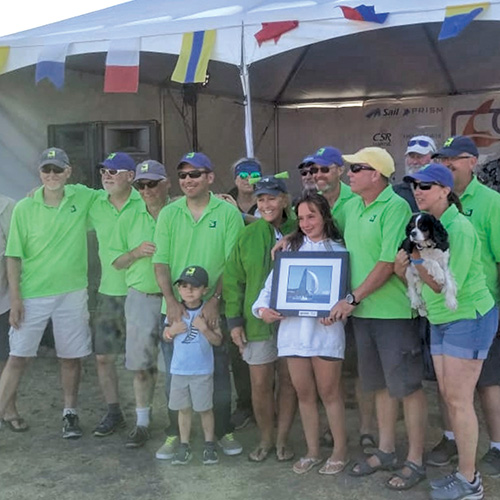
If you’d like to share the story of your boat in a MY BOAT column, we’d love to hear from you. Please email 48° North Editor Andy Cross to get started (andy@48north.com).
Editor
48° North Editors are committed to telling the best stories from the world of Pacific Northwest boating. We live and breathe this stuff, and share your passion for the boat life. Feel free to keep in touch with tips, stories, photos, and feedback at news@48north.com.
